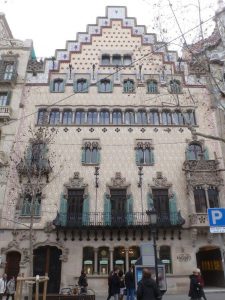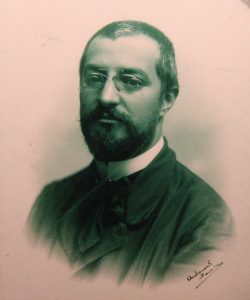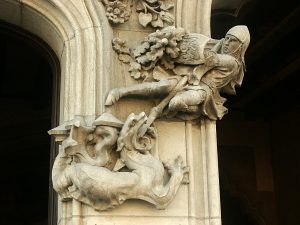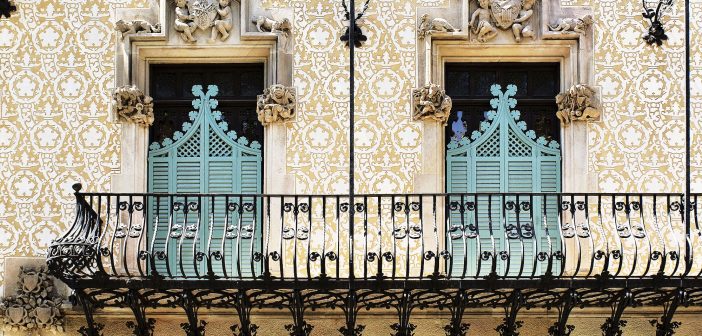 While Barcelona’s Passeig de Gràcia may be excellent for shopping and walking around on a sunny afternoon, it’s also is famous for its architecture. On this large street stands one of the most famous city blocks in the entire city, the “Manzana de la Discòrdia” (Block of Discord). This remarkable block has buildings by four of Barcelona’s most important Modernist architects, Antoni Gaudí, Lluís Domènech i Montaner, Josep Puig i Cadafalch, and Enric Sagnier. It is among these structures that one can see Casa Amatller, one of the important buildings on the Manzana de la Discordia.
While Barcelona’s Passeig de Gràcia may be excellent for shopping and walking around on a sunny afternoon, it’s also is famous for its architecture. On this large street stands one of the most famous city blocks in the entire city, the “Manzana de la Discòrdia” (Block of Discord). This remarkable block has buildings by four of Barcelona’s most important Modernist architects, Antoni Gaudí, Lluís Domènech i Montaner, Josep Puig i Cadafalch, and Enric Sagnier. It is among these structures that one can see Casa Amatller, one of the important buildings on the Manzana de la Discordia.
 Designed by Josep Puig i Cadafalch, Casa Amatller was actually originally designed as a residence for chocolatier Antoni Amatller Costa (for whom the building was named). On March 12, 1898, Amatller bought an estate of 1,415 m2 that consisted of four floors and a garden for 490,000 pesetas (about 2,950€). He then ordered the remodeling of the building in order to convert it into a residence, turning to Josep Puig who, at the time, was an architect, art historian and politician. Puig believed that Catalonia had been going through several centuries of decay, and only regained its economic power throughout the 19th century due to industrialization. He felt that Catalonia needed to project an image of progress through modern architecture, using traditional arts as a way to adapt to new materials and designs. Using the cooperation of various craft workshops revived by the historical and literary renaissance, he was able to make this dream into a reality, causing a radical transformation of the building. This included but is not limited to: the demolition and reconstruction of the façade, construction of a studio roof, restructuring and redecoration of the ground floor, substantial changes in the redecoration of the main floor, addition of an elevator and electrical installations, and rehabilitation of kitchens and bathrooms.
Designed by Josep Puig i Cadafalch, Casa Amatller was actually originally designed as a residence for chocolatier Antoni Amatller Costa (for whom the building was named). On March 12, 1898, Amatller bought an estate of 1,415 m2 that consisted of four floors and a garden for 490,000 pesetas (about 2,950€). He then ordered the remodeling of the building in order to convert it into a residence, turning to Josep Puig who, at the time, was an architect, art historian and politician. Puig believed that Catalonia had been going through several centuries of decay, and only regained its economic power throughout the 19th century due to industrialization. He felt that Catalonia needed to project an image of progress through modern architecture, using traditional arts as a way to adapt to new materials and designs. Using the cooperation of various craft workshops revived by the historical and literary renaissance, he was able to make this dream into a reality, causing a radical transformation of the building. This included but is not limited to: the demolition and reconstruction of the façade, construction of a studio roof, restructuring and redecoration of the ground floor, substantial changes in the redecoration of the main floor, addition of an elevator and electrical installations, and rehabilitation of kitchens and bathrooms.
 The building perfectly represents the Modernisme style of architecture that was popular during the period. Located directly to the left of the famous Casa Batlló, the façade of the building is very different from Gaudí’s creation in that it is much more rigid in texture and portrays a much more traditional neo-Gothic feeling. The house now functions as a museum for anyone to come visit, as long as you purchase a ticket in the lobby of the building or in advance on the website. It also has the Amatller Institute of Hispanic Art, which records the research and documentation of the history of art made available to researchers in a specialized library that includes over 30,000 titles. If you’re interested in reading more about the famous building or plan to go visit the site yourself, take a look at Casa Amatller’s website.
The building perfectly represents the Modernisme style of architecture that was popular during the period. Located directly to the left of the famous Casa Batlló, the façade of the building is very different from Gaudí’s creation in that it is much more rigid in texture and portrays a much more traditional neo-Gothic feeling. The house now functions as a museum for anyone to come visit, as long as you purchase a ticket in the lobby of the building or in advance on the website. It also has the Amatller Institute of Hispanic Art, which records the research and documentation of the history of art made available to researchers in a specialized library that includes over 30,000 titles. If you’re interested in reading more about the famous building or plan to go visit the site yourself, take a look at Casa Amatller’s website.



